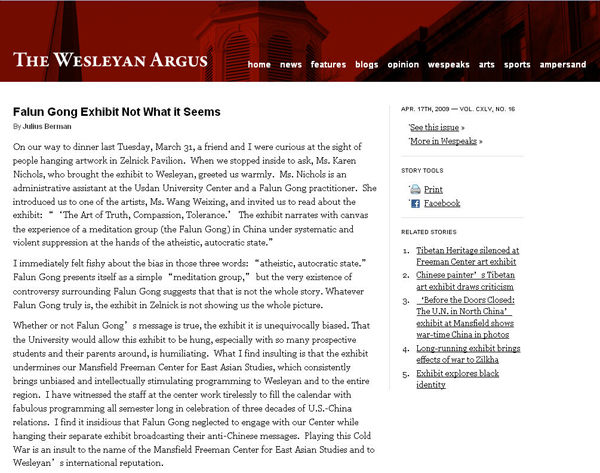On our way to dinner last Tuesday, March 31, a friend and I were curious at the sight of people hanging artwork in Zelnick Pavilion. When we stopped inside to ask, Ms. Karen Nichols, who brought the exhibit to Wesleyan, greeted us warmly. Ms. Nichols is an administrative assistant at the Usdan University Center and a Falun Gong practitioner. She introduced us to one of the artists, Ms. Wang Weixing, and invited us to read about the exhibit: "'The Art of Truth, Compassion, Tolerance.' The exhibit narrates with canvas the experience of a meditation group (the Falun Gong) in China under systematic and violent suppression at the hands of the atheistic, autocratic state."
I immediately felt fishy about the bias in those three words: "atheistic, autocratic state." Falun Gong presents itself as a simple "meditation group," but the very existence of controversy surrounding Falun Gong suggests that that is not the whole story. Whatever Falun Gong truly is, the exhibit in Zelnick is not showing us the whole picture.
Whether or not Falun Gong's message is true, the exhibit it is unequivocally biased. That the University would allow this exhibit to be hung, especially with so many prospective students and their parents around, is humiliating. What I find insulting is that the exhibit undermines our Mansfield Freeman Center for East Asian Studies, which consistently brings unbiased and intellectually stimulating programming to Wesleyan and to the entire region. I have witnessed the staff at the center work tirelessly to fill the calendar with fabulous programming all semester long in celebration of three decades of U.S.-China relations. I find it insidious that Falun Gong neglected to engage with our Center while hanging their separate exhibit broadcasting their anti-Chinese messages. Playing this Cold War is an insult to the name of the Mansfield Freeman Center for East Asian Studies and to Wesleyan's international reputation.
Falun Gong uses this exhibit on a global scale to force institutions like Wesleyan to choose sides in their battle. Now they have put the Wesleyan community in an impossible position. By allowing the exhibit, the University sets itself up for ridicule by its peers, but by protesting the exhibition, the community sets itself up for attack by Falun Gong. This danger is real: probing online reveals that everywhere this exhibit has cropped up and faced opposition, Falun Gong has launched a propaganda attack ultimately wiping out records of protest and slipping in its own message, accusing community leaders of being Communists or Chinese agents. Look at Tel Aviv University and University of Western Ontario for example. Because of this, I am afraid that publishing this Wespeak makes me vulnerable to attack. To avoid further humiliation, we must not shut down the exhibit. We must be gracious as a community. In fact, we should each do what the exhibit calls us to do: develop an awareness of this issue. Go look at the paintings and read their literature, but stay mindful of its bias. Sift through the propaganda from both sides – the Internet is a battlefield upon which Falun Gong and the People's Republic of China have amassed arms for the past ten years. Find your truth but don't be taken in by biased propaganda.
I can't say whether or not Falun Gong's message is true. I don't know whether or not Falun Gong is a cult, but I know that cults gain sympathy by preying on people's weaknesses. Falun Gong wants to take advantage of the fact that Wesleyan does not understand both sides of the controversy. They are banking on the assumption that the average Wes student is na?ve, uninformed, and politically active. Wesleyan, take time to educate yourself on this issue.
(Wesleyanargus.com, April 17, 2009)

Original text from: http://wesleyanargus.com/2009/04/17/falun-gong-exhibit-not-what-it-seems/





